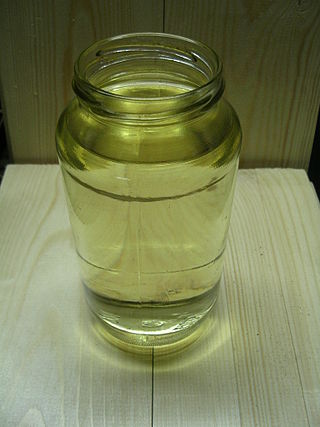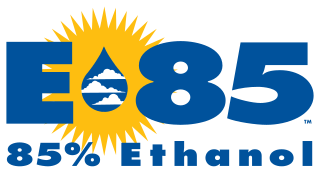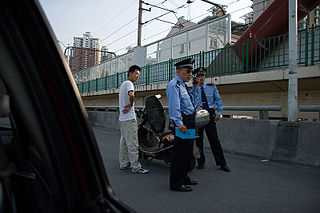Kerosene, or paraffin, is a combustible hydrocarbon liquid which is derived from petroleum. It is widely used as a fuel in aviation as well as households. Its name derives from Greek: κηρός (kērós) meaning "wax", and was registered as a trademark by Nova Scotia geologist and inventor Abraham Gesner in 1854 before evolving into a generic trademark. It is sometimes spelled kerosine in scientific and industrial usage.

Gasoline or petrol is a petrochemical product characterized as a transparent, yellowish, and flammable liquid normally used as a fuel for spark-ignited internal combustion engines. When formulated as a fuel for engines, gasoline is chemically composed of organic compounds derived from the fractional distillation of petroleum and later chemically enhanced with gasoline additives. It is a high-volume profitable product produced in crude oil refineries.

A filling station is a facility that sells fuel and engine lubricants for motor vehicles. The most common fuels sold in the 2010s were gasoline and diesel fuel.
An octane rating, or octane number, is a standard measure of a fuel's ability to withstand compression in an internal combustion engine without undergoing pre-ignition. The higher the octane number, the more compression the fuel can withstand before detonating. Octane rating does not relate directly to the power output or the energy content of the fuel per unit mass or volume, but simply indicates gasoline's resistance to detonating under pressure without a spark.
A fuel tax is an excise tax imposed on the sale of fuel. In most countries the fuel tax is imposed on fuels which are intended for transportation. Fuel tax receipts are often dedicated or hypothecated to transportation projects, in which case the fuel tax can be considered a user fee. In other countries, the fuel tax is a source of general revenue. Sometimes, a fuel tax is used as an ecotax, to promote ecological sustainability. Fuel taxes are often considered by government agencies such as the Internal Revenue Service as regressive taxes.

Liquefied petroleum gas, also referred to as liquid petroleum gas, is a fuel gas which contains a flammable mixture of hydrocarbon gases, specifically propane, n-butane and isobutane. It can sometimes contain some propylene, butylene, and isobutene.

A Natural Gas Vehicle (NGV) utilizes compressed natural gas (CNG) or liquefied natural gas (LNG) as an alternative fuel source. Distinguished from autogas vehicles fueled by liquefied petroleum gas (LPG), NGV's rely on methane combustion, resulting in cleaner emissions due to the removal of contaminants from the natural gas source.

E85 is an abbreviation typically referring to an ethanol fuel blend of 85% ethanol fuel and 15% gasoline or other hydrocarbon by volume.

A flexible-fuel vehicle (FFV) or dual-fuel vehicle is an alternative fuel vehicle with an internal combustion engine designed to run on more than one fuel, usually gasoline blended with either ethanol or methanol fuel, and both fuels are stored in the same common tank. Modern flex-fuel engines are capable of burning any proportion of the resulting blend in the combustion chamber as fuel injection and spark timing are adjusted automatically according to the actual blend detected by a fuel composition sensor. Flex-fuel vehicles are distinguished from bi-fuel vehicles, where two fuels are stored in separate tanks and the engine runs on one fuel at a time, for example, compressed natural gas (CNG), liquefied petroleum gas (LPG), or hydrogen.

Autogas or LPG is liquefied petroleum gas (LPG) used as a fuel in internal combustion engines in vehicles as well as in stationary applications such as generators. It is a mixture of propane and butane.

A fuel gas-powered scooter is a scooter powered by fuel gas. Fuel gases include such fuels such as liquefied petroleum gas (LPG), compressed natural gas (CNG), biogas and hydrogen (HICE). Hydrogen use in two-wheelers has only recently being started to be looked into, mainly by developing countries, to decrease local pollution at an affordable cost.

A fuel card or fleet card is used as a payment card most commonly for gasoline, diesel, and other fuels at gas stations. Fleet cards can also be used to pay for vehicle maintenance and expenses at the discretion of the fleet owner or manager. Most fuel cards are charge cards.

The usage and pricing of gasoline results from factors such as crude oil prices, processing and distribution costs, local demand, the strength of local currencies, local taxation, and the availability of local sources of gasoline (supply). Since fuels are traded worldwide, the trade prices are similar. The price paid by consumers largely reflects national pricing policy. Most countries impose taxes on gasoline (petrol), which causes air pollution and climate change; whereas a few, such as Venezuela, subsidize the cost. Some country's taxes do not cover all the negative externalities, that is they do not make the polluter pay the full cost. Western countries have among the highest usage rates per person. The largest consumer is the United States.

Coryton Refinery was an oil refinery in Essex, England, on the estuary of the River Thames 28 miles (45 km) from central London, between Shell Haven Creek and Hole Haven Creek, which separates Canvey Island from the mainland.
The 2007 gasoline rationing plan in Iran was launched by president Mahmoud Ahmadinejad's cabinet to reduce that country's fuel consumption. Although Iran is one of the world's largest producers of petroleum, rapid increases in demand and limited refining capacity have forced the country to import about 40% of its gasoline, at an annual cost of up to USD $7 billion.
GasBuddy is a technology company headquartered in Dallas that offers mobile applications and websites for tracking crowd-sourced locations and prices of gas stations and convenience stores in the United States and Canada. Their platforms offer information sourced from users, gas station operators, and partner companies. They also provide business-to-business services to gas stations and convenience store owners.

Petroleum has been a major industry in the United States since the 1859 Pennsylvania oil rush around Titusville, Pennsylvania. Commonly characterized as "Big Oil", the industry includes exploration, production, refining, transportation, and marketing of oil and natural gas products. The leading crude oil-producing areas in the United States in 2023 were Texas, followed by the offshore federal zone of the Gulf of Mexico, North Dakota and New Mexico.

OKKO is the network of filling complexes in Ukraine. The owner of OKKO network is open joint-stock company Galnaftogaz.

A gasoline pump or fuel dispenser is a machine at a filling station that is used to pump gasoline (petrol), diesel, or other types of liquid fuel into vehicles. Gasoline pumps are also known as bowsers or petrol bowsers, petrol pumps, or gas pumps.
Fuel Pricing Software is a business tool intended to allow retail fuel marketers to determine the most appropriate price at which to offer fuel based on their pricing strategies.













